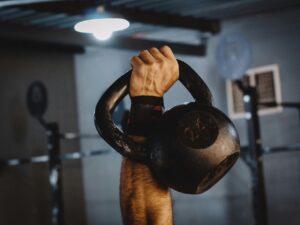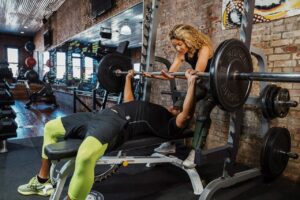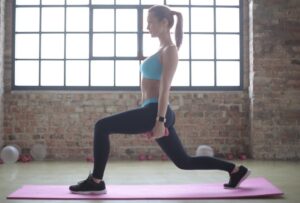Ab training is somewhat controversial. On the one hand, we have people who love doing ab workouts for core strength and definition.
But on the other hand, some folks think that big compound lifts like squats are enough to train the abs and make them grow.
So, who is right here? Like any muscle in the body, your abs benefit from direct work. Look at it this way:
You wouldn’t skip bicep curls because you do back exercises, would you? Then why treat your abs differently?
To that end, let’s review 14 of the best exercises for a killer upper abs workout.
The 14 Best Upper Ab Exercises
1. Cable Crunch
Weighted cable crunches are one of the simplest exercises for the upper abs. The biggest advantage of the movement is that you can adjust the resistance to fit your current abilities and gradually increase the difficulty by using more weight.
A higher resistance would allow you to provide the necessary stimulus without doing 20, 30, or even 40+ reps per set (1).
How to:
- Set the pulley in the highest position, connect a rope attachment, and select the appropriate load.
- Grab both ends of the rope and get down on your knees.
- Lean forward and position the rope behind your head with your hands at the sides of your neck.
- Take a deep breath and engage your midsection.
- Initiate the first rep by squeezing your abs to draw your ribcage closer to your pelvic bone. Doing so will cause your elbows to get closer to your thighs.
- Pause briefly and extend your torso as you exhale.
- Take another breath and repeat.
Pro tip:
One of the most common errors people make with the cable crunch is to flex and extend their hips instead of training the abs. To avoid the error, engage your abs at the start and initiate the motion from your midsection.
The objective isn’t to move your torso up and down but to crunch and extend at the midsection.
The difference is subtle, but crunching your torso will result in much better ab engagement.
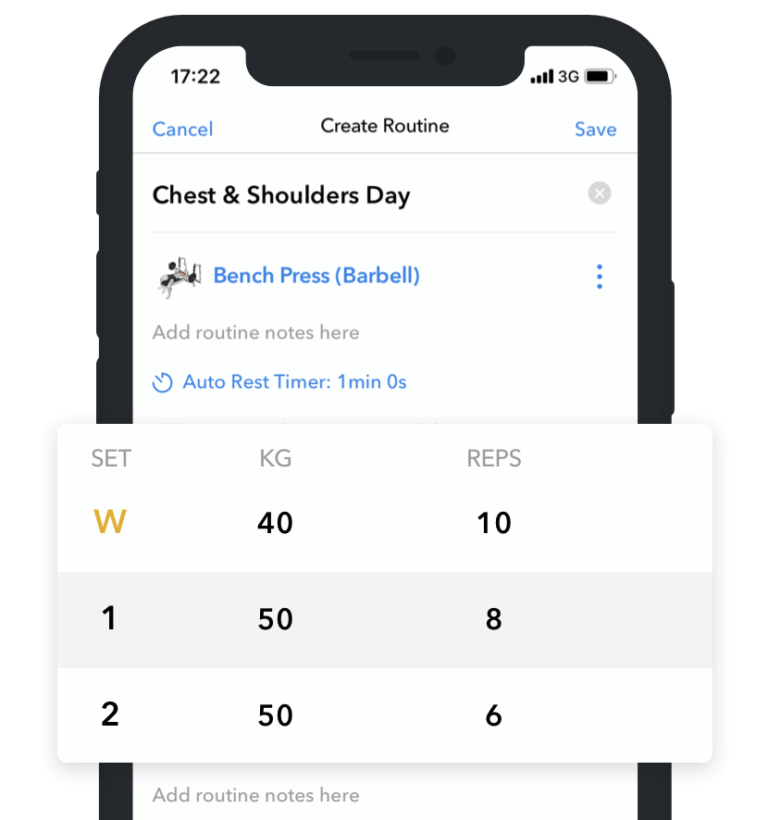
Hevy – Workout Tracker







Hevy – Workout Tracker
Create and log your upper abs workout with Hevy and track your progress
2. Plank-to-Toe Touch
The plank-to-toe touch is an advanced variation of the classic exercise that develops the core, chest, arms, upper back, and lower body.
How to:
- Get down on all fours and extend your body into a high plank position with your legs straight, your feet a few inches apart, your upper body engaged, and your back neutral.
- Place your hands slightly more than shoulder-width apart, similar to how you would for push-ups.
- Take a deep breath and engage your abs.
- Push your buttocks toward the ceiling to fold your body while keeping your back neutral.
- Simultaneously lift your right hand off the ground and reach diagonally across your body to tap the tip of your left foot.
- Bring your hand to the starting position as you lower your buttocks to the starting position and exhale.
- Take another breath and lift your buttocks, bringing your left hand to the tip of your right foot.
- Keep alternating between left and right until you’re done.
Pro tip:
One common error with the movement is keeping the buttocks high and only training through a partial range of motion. Doing so allows you to complete more reps, but each one is less effective.
Do each rep smoothly and with good body control. Reach far enough to tap your foot and lower your hips to the starting position before initiating a new rep.
3. V Up
V-ups are a more advanced variation of classic sit-ups. Instead of only raising your torso from a lying to an upright position, you lift your upper and lower body simultaneously, folding yourself.
When seen from the side, your body should resemble the letter V at the top of each rep, hence the movement’s name.
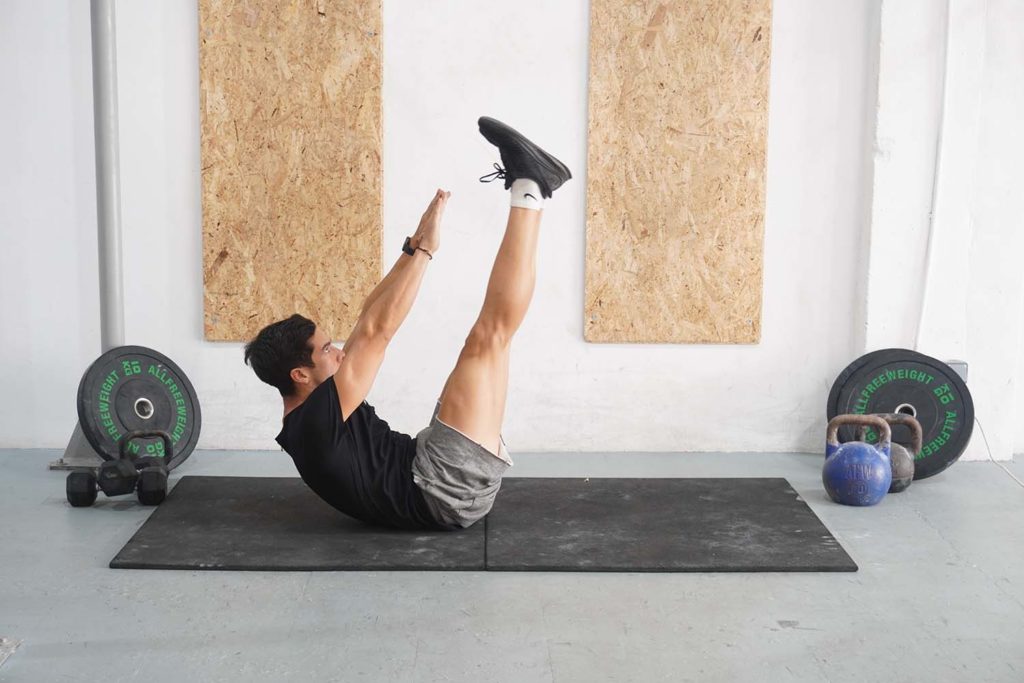

How to:
- Place an exercise mat on the floor and lie flat with your legs straight and feet together.
- Engage your abs and extend your arms behind your head while keeping your hands a few inches apart.
- Lift your feet an inch or two off the floor and squeeze your abs to prevent your lower back from arching.
- Take a breath and lift your torso and legs toward the ceiling, aiming to touch your toes with your hands.
- Pause at the top and slowly unfold your body while keeping your abs engaged.
- Exhale but keep your arms and feet in the air.
- Take another breath and repeat.
Pro tip:
A good V-up repetition is one where you raise your upper and lower body simultaneously. Doing so makes it easier to stay in position and prevents your body from rocking back and forth.
Additionally, strive to complete each repetition slowly and with excellent body control. The activity is challenging and forces many people to use momentum to complete more repetitions. Regular tempo and good body control allow you to emphasize the rectus abdominis.
4. Hanging Knee Raise
Hanging knee raises are one of the more accessible upper abs exercises. You only need a pull-up bar and can overload your muscles by doing more reps, introducing external weights, and more.
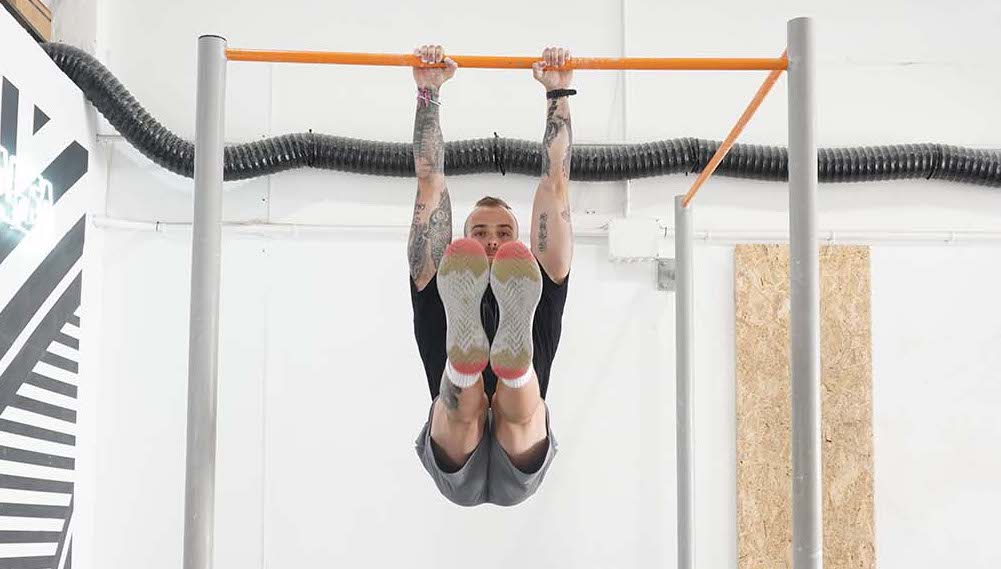

How to:
- Reach up and grab a pull-up bar with an overhand grip (palms facing forward). Use a grip width that feels comfortable.
- Engage your abs and lift your feet off the floor, suspending yourself in the air. Have your arms straight to prevent overworking your biceps.
- Bring your feet together and take a deep breath.
- Slowly lift your legs as you bend your knees at approximately 90 degrees.
- Raise your knees as high as possible––ideally, until they are at hip level.
- Pause for a moment and slowly lower your knees as you extend them.
- Exhale near the bottom; don’t rest your feet on the ground.
- Take another breath and repeat.
Pro tip:
Start with slow reps and lift your knees as high as possible in one fluid motion. An error trainees make is to jerk their knees up, which robs their abs of tension.
Slow reps will make the exercise more challenging, but each repetition will be more stimulative for your core muscles.
Related article: The Top 7 Isolation And 7 Compound Ab Exercises
5. Hanging Leg Raises (Toes to Bar)
Like the previous movement on our list, hanging leg raises are great for targeting the core muscles. The difference is that keeping your legs straight makes the exercise much more challenging. Only the most advanced trainees should attempt to lift their toes to the bar.
How to:
- Reach up and grab a pull-up bar with an overhand grip (palms facing forward).
- Engage your abs, bring your feet together, and lift them off the floor to suspend yourself in the air.
- Take a deep breath and lift your legs in one fluid motion, raising them as much as your rectus abdominis strength allows––ideally until your toes reach the pull-up bar.
- Pause briefly and lower your legs to the starting position as you exhale. Don’t rest your feet on the floor.
- Take another breath and repeat.
Pro tip:
Like knee raises, slow and controlled reps work best. Raising your legs slowly allows you to keep the tension on your abdominal muscles, which causes a stronger stimulus and better results.
Aside from robbing your upper and lower abs of tension, moving your legs up and down quickly can cause your lower back to arch, leading to stress and pain.







Hevy – Workout Tracker







Hevy – Workout Tracker
Create and log your upper abs workout with Hevy and track your progress
6. Toe Reaches
Toe reaches are among the more beginner-friendly bodyweight abs exercises you can do for core strength and an impressive six-pack.
One advantage of the movement is that it encourages a neutral lumbar spine due to your body’s position while performing the exercise. Crunching your torso while having your legs in a vertical position reduces the risk of arching your lower back, making it easier to keep the tension on your abs muscles.
How to:
- Place an exercise mat on the floor and lie down.
- Bring your feet together, engage your abs, and lift your legs vertically. Your feet should be directly over your hips with your knees straight.
- Have your arms straight and over your chest.
- Take a deep breath, engage your abs, and crunch your torso, lifting your shoulder blades off the ground.
- Touch your toes with your fingertips and lower your torso to the floor as you exhale.
- Take another breath and repeat.
Pro tip:
Like other upper ab exercises, initiate each repetition by crunching your abdominal muscles. Imagine that you’re trying to fold your torso instead of simply lifting your shoulder blades off the ground.
The difference is subtle but can result in much better rectus abdominis activation.
7. Sit Up
Sit-ups are a classic upper abs exercise (2). However, unlike V-ups, you only have to raise your torso, which makes the activity more beginner-friendly.
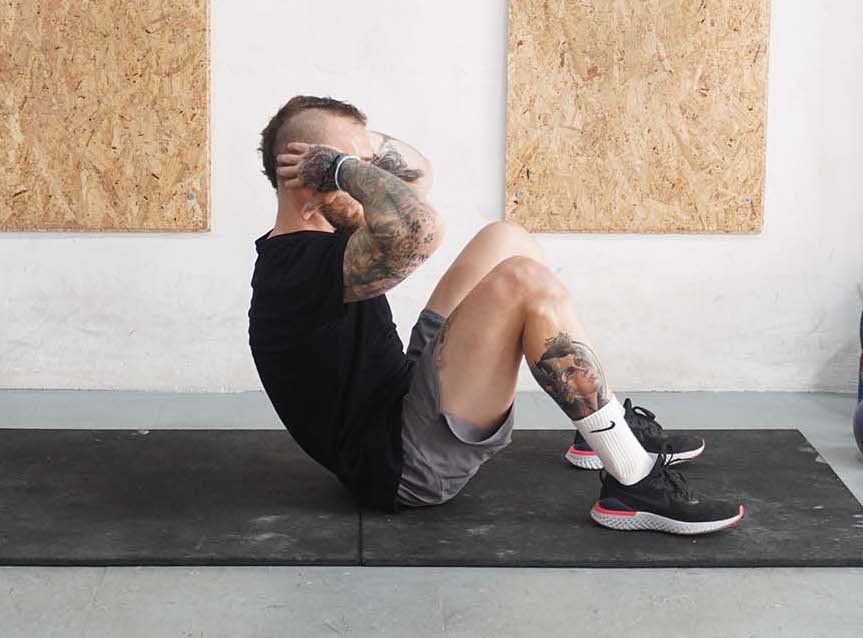

How to:
- Place an exercise mat on the floor and lie down.
- Have your knees bent and feet flat on the ground.
- Place your hands behind your head without interlocking your fingers.
- Take a deep breath and initiate the first rep by engaging your ab muscles.
- Raise your torso to an almost upright position and pause briefly. Don’t go further because a vertical torso means no tension on the rectus abdominis. Instead, other muscle groups take over to keep you in position.
- Slowly lower your upper body to the ground while keeping the tension on your core muscles.
- Exhale near the bottom.
- Take another breath and repeat.
Pro tip:
One common error with sit-ups is simply moving the torso up and down with no regard for muscle activation. Doing the movement that way isn’t fatal or dangerous, but it affects how well you can activate the rectus abdominis muscle.
One simple tweak is to focus on crunching your torso instead of simply moving it up. To do that, initiate each repetition by flexing your abs muscles and feeling the area work. You should feel an intense burn in your upper ab area by the end of each set.
8. Crunch
Crunches are similar to sit-ups, apart from one difference. Instead of lifting your torso to an almost upright position, the objective is only to raise your shoulder blades off the ground.
Both exercises are beneficial, and you should do the one that feels best for your rectus abdominis (3).
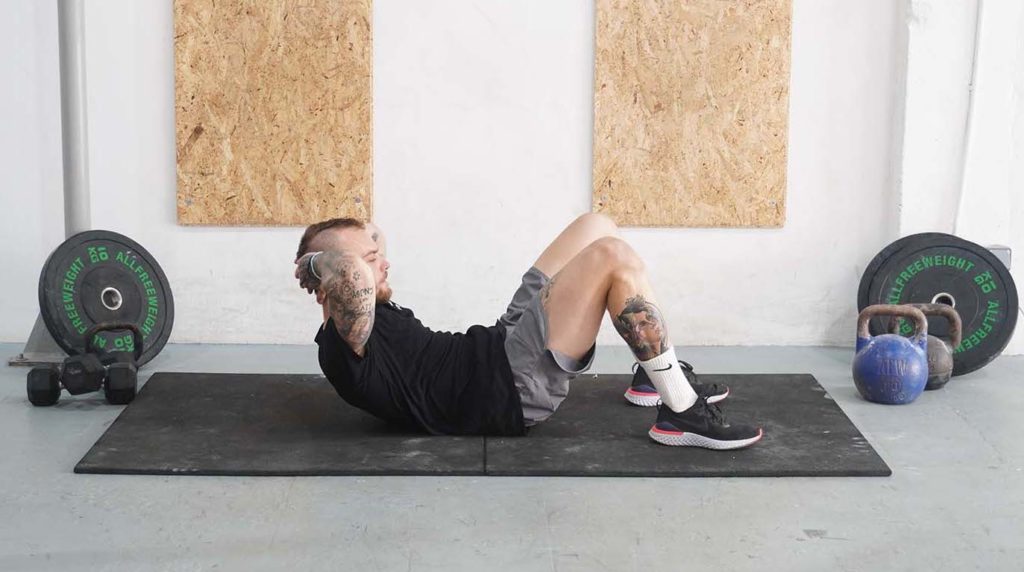

How to:
- Place an exercise mat on the floor and lie down.
- Have your knees bent and feet flat on the floor.
- Bend your arms and place your hands on your chest or behind your head.
- Take a deep breath and initiate the first rep by crunching your upper abs and lifting your shoulder blades several inches off the ground.
- Pause briefly and lower your torso to the starting position as you exhale.
Pro tip:
Doing slow and controlled crunches will provide the necessary challenge, but only for a time.
A neat way to make the movement more challenging is to bend your legs and position your knees over your hips. In addition to training the upper ab area, your lower abs will activate more, leading to better strength gain.
9. Inchworm
The inchworm is not your traditional upper abs exercise but offers plenty of benefits. Most notably, it is a more intense exercise that trains the six-pack abs in a functional way.
Instead of doing a controlled motion to target the rectus abdominis, you must perform a complex, full-body exercise and engage your entire core alongside a range of other muscles.
As a result, there is a more significant carryover to dynamic and athletic motions like the squat, deadlift, overhead press, etc.
How to:
- Stand tall with your feet a few inches apart, arms extended, and gaze directed a few feet forward.
- Take a deep breath and engage your six-pack abs.
- Lean your torso forward and plant your hands flat on the ground while maintaining a slight knee bend. Some spinal flexion (rounding) is entirely okay.
- Slowly walk your hands forward as you lower your hips, getting your body in a horizontal position or close to one. Ideally, you will walk your hands enough to be in front of your body, similar to an extended plank position, but start with what feels manageable.
- Hold the position briefly and start walking your hands back toward your feet, folding your body along the way.
- Once your hands are close enough to your feet, stand up and exhale.
- Alternatively, walk your hands to your feet, tap your toes and immediately initiate the next repetition.
Pro tip:
Like all other exercises on our list, one of the best things you can do is slow down. Doing so makes it easier to maintain proper form and limit the impact on your wrists and elbows.
Walking your hands forward and back more quickly might feel like a more ‘athletic’ exercise, but it causes more stress, leading to joint aches.
You might also like: Killer Lower Ab Workout to Achieve a Shredded Core
10. Ab Wheel
Ab wheel rollouts are another functional activity that develops core stability and strength. In addition to working the superficial rectus abdominis muscle, rollouts develop the deep core muscles.
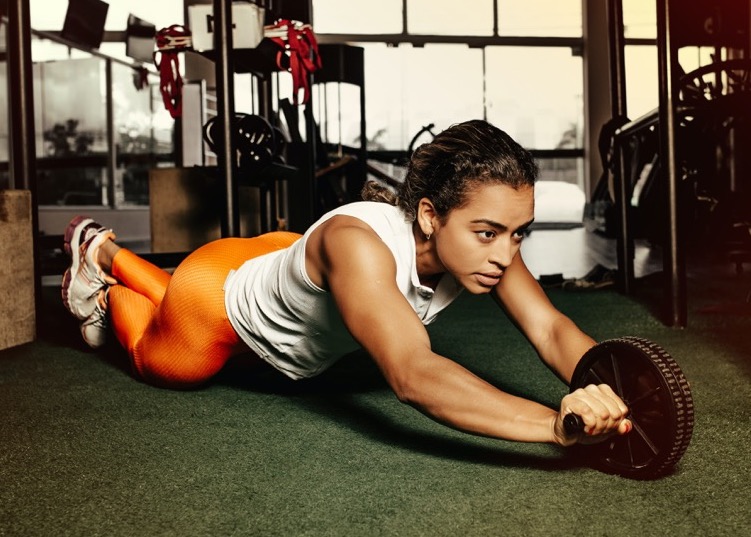

How to:
- Get down on your knees with an ab wheel in your hands.
- Grab the ab wheel’s handles with an overhand grip (palms facing down), lean forward, and place the wheel on the ground.
- Take a deep breath and engage your abs. Some degree of spinal flexion (rounding) is beneficial to prevent lower back stress.
- Inhale again and slowly roll the wheel forward as you lean your torso into a horizontal position.
- Descend as much as your core stability and strength allow and pause briefly. Ideally, your arms should extend in front of your body for optimal six-pack abs activation.
- Roll the wheel back toward your thighs while keeping your abs engaged and lower back slightly rounded.
- Exhale near the end.
- Take another breath and repeat.
Pro tip:
One neat way to improve upper body stability and perform more reps on the ab wheel rollout is to rotate your elbows inward and have them point back instead of to your sides. It should feel like you’re trying to bend the ab wheel’s handles when you set up for each set.
Such an elbow position provides additional stability through your arms, making it less likely for your arms to bend. In addition, the extra tension would translate to more shoulder and upper back stability, allowing you to maintain your position even as you roll forward.
11. Hollow Rock/Hold
The hollow rock/hold is one of the best upper abs exercises. Like a plank, it trains the core and other muscle groups through an isometric contraction. In other words, the objective is to maintain a static position for a specific period, forcing the involved muscles to produce force.
Hollow rock/holds are a fantastic addition to almost any upper body and abs workout simply because they work well in combination with many isolation and compound activities.
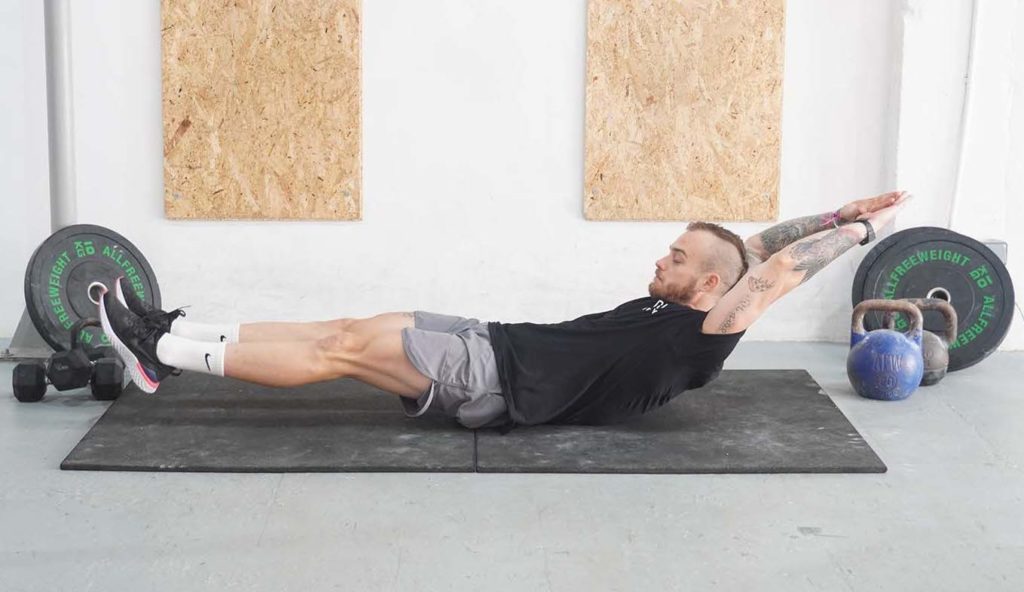

How to:
- Place an exercise mat on the floor and lie down.
- Straighten your arms and position them behind your head. Bring your hands together.
- Straighten your legs and put your feet together.
- Take a deep breath and engage your abs to create some spinal flexion, putting your lower back in contact with the exercise mat.
- Simultaneously lift your feet and hands a few inches off the ground.
- Hold the position for 30 to 60 seconds and take deep breaths.
- Optional: Rock your body forward and back gently while maintaining a rigid body position.
Pro tip:
As someone new to the exercise, begin by holding a position for as long as possible.
If you rock your body back and forth, keep the movement limited and maintain your initial body position. One common mistake is rocking too aggressively, which can cause you to lose stability.
12. Crunch (Machine)
Like cable crunches, the machine crunch is a fantastic exercise to strengthen the rectus abdominis.
One benefit of the activity is that you can control the resistance level by using more or less weight. Beginners can start with a bit of resistance to train their abs and improve muscle activation.
How to:
- Select the appropriate load and adjust your seat height. The bottom pad should be against your lower shin as you sit down for the exercise.
- Sit down, straighten your back, secure your feet on the bottom pads, and grab the handles to the sides of your head.
- Take a deep breath and crunch your torso forward, squeezing your abs as hard as possible.
- Pause for a moment and slowly extend your torso as you exhale.
- Take another breath and repeat.
Pro tip:
The precise way to do the exercise will depend on what type of machine you have available, but always remember to initiate reps through your core.
Like all other ab exercises, the objective isn’t simply to move your torso from point A to B but to crunch and bring your ribcage closer to your pelvic bone.
13. Straight Arm Weighted Crunch
Straight-arm weighted crunches are a lesser-known exercise that overloads the abs quite well.
Like the previous movement on our list, a notable advantage is that you can adjust the resistance by using the appropriate load for your current ability. For instance, you can start with as little as 10 lbs and gradually bump the intensity as you strengthen your midsection.
How to:
- Grab a pair of light dumbbells, kettlebells, or weight plates.
- Lie flat on the ground, straighten your arms and position the weights over your chest.
- Bend your knees and plant your feet on the ground.
- Take a deep breath, engage your abs, and initiate the first rep by crunching your abs.
- Lift your shoulder blades several inches off the floor, pause briefly, and lower your torso to the floor as you exhale.
- Take another breath and repeat.
Pro tip:
You can shift the emphasis to the obliques (the muscles running along both sides of the rectus abdominis) by holding a single weight in one hand. Doing so allows you to introduce a slight torso rotation as you do crunches.
14. Weighted Decline Sit Up
Weighted decline sit-ups are a more advanced core exercise that allows you to control the resistance by selecting the appropriate load.
You can hold a dumbbell, kettlebell, or weight plate for resistance.
How to:
- Set the bench at the appropriate decline. Start with a smaller angle and gradually work up to 45-60 degrees.
- Place the weight next to the bench and within a reaching distance.
- Set yourself up on the bench and secure your legs on the pads.
- Reach to your side, grab the weight carefully and position it over your chest. Then, grab the weight with both hands for extra support.
- Take a deep breath, engage your abs, and initiate the first rep by crunching your torso.
- Lift your upper body to an almost upright position and pause briefly.
- Slowly lower your torso to the starting position as you exhale. Maintain ab tension and avoid arching your lower back as you complete each repetition.
Pro tip:
The weighted decline sit-up is an excellent addition to upper ab workouts. You can switch things up and work on rotational strength by introducing a twisting motion to each repetition.
As you raise your torso, slowly rotate in one direction and pause at the top. Then, on the next rep, turn in the opposite direction and continue alternating for the duration of the set.
A Brief Look at the Abs and How to Train Them
The rectus abdominis, commonly called the six-pack, is a flat and long muscle that covers the area between the ribcage and pelvic bone (4). Its primary functions are to crunch the torso (bringing the ribcage and pelvis closer) and provide torso stability during various exercises.
When people talk about the upper abs, they refer to the upper region of the rectus abdominis muscle. Despite being part of a larger muscle, the above exercises can emphasize the area, just as various chest exercises can focus on the lower, middle, or upper pecs (5).
Bodybuilding is an art that requires discipline and proper technique for trainees to target the correct areas and develop their muscles thoroughly. Muscle-building principles fully apply to the abs because the best ways to target a specific region are:
- Picking exercises that emphasize the desired region of a muscle group
- Striving to form a mind-muscle connection and activate the correct muscles on every rep
Within the context of today’s article, the best workouts for upper abs will include some combination of movements from our list. In addition, the job of every trainee is to maintain proper technique and initiate each repetition by first engaging the upper region of the abs.
Trainees who can’t hit the gym as frequently can do combined abs and upper body workouts. For instance, you can begin each workout by training the larger muscle groups (back complex, chest, etc.) and conclude with some ab-specific training.
Related article: Free Workout Plans for Every Fitness Level
Final Thoughts
Like any muscle in your body, the abs benefit from direct work, progressive overload, and intelligent exercise selection.
The above are the 14 best exercises to emphasize the upper abs, strengthen the area, and develop core stability.
If you’re looking for further assistance in finding good exercises, putting together workouts, and tracking your progress, check out the Hevy app.







Hevy – Workout Tracker







Hevy – Workout Tracker
Create and log your upper abs workout with Hevy and track your progress
FAQs
1. How do I isolate my upper abs?
It’s impossible to truly isolate your upper abs because they are a region of the rectus abdominis.
The best upper ab workouts don’t isolate the area; they only emphasize it, allowing it to develop slightly quicker than the rest of the core musculature.
2. Do planks work the upper abs?
Planks make for a quick ab workout and train the upper portion of the muscle. The activity also works the obliques, transverse abdominis, back complex, shoulders, chest, glutes, and other major muscle groups.
3. Why do the upper abs show first?
The upper abs generally show first for most people, not because they develop more quickly but because people store less fat in the area compared to the lower abdomen.


